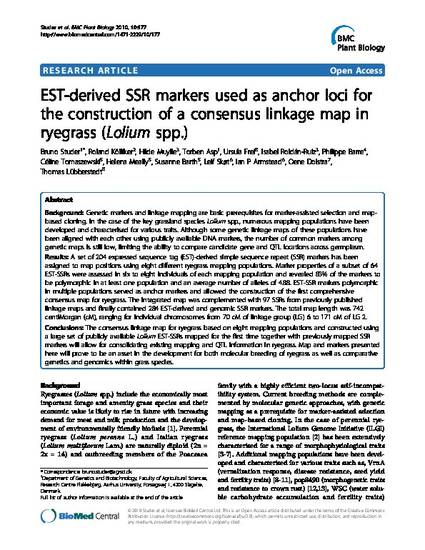
Background
Genetic markers and linkage mapping are basic prerequisites for marker-assisted selection and map-based cloning. In the case of the key grassland species Lolium spp., numerous mapping populations have been developed and characterised for various traits. Although some genetic linkage maps of these populations have been aligned with each other using publicly available DNA markers, the number of common markers among genetic maps is still low, limiting the ability to compare candidate gene and QTL locations across germplasm. Results
A set of 204 expressed sequence tag (EST)-derived simple sequence repeat (SSR) markers has been assigned to map positions using eight different ryegrass mapping populations. Marker properties of a subset of 64 EST-SSRs were assessed in six to eight individuals of each mapping population and revealed 83% of the markers to be polymorphic in at least one population and an average number of alleles of 4.88. EST-SSR markers polymorphic in multiple populations served as anchor markers and allowed the construction of the first comprehensive consensus map for ryegrass. The integrated map was complemented with 97 SSRs from previously published linkage maps and finally contained 284 EST-derived and genomic SSR markers. The total map length was 742 centiMorgan (cM), ranging for individual chromosomes from 70 cM of linkage group (LG) 6 to 171 cM of LG 2. Conclusions
The consensus linkage map for ryegrass based on eight mapping populations and constructed using a large set of publicly available Lolium EST-SSRs mapped for the first time together with previously mapped SSR markers will allow for consolidating existing mapping and QTL information in ryegrass. Map and markers presented here will prove to be an asset in the development for both molecular breeding of ryegrass as well as comparative genetics and genomics within grass species.
Available at: http://works.bepress.com/thomas-lubberstedt/23/

This article is published as Studer, Bruno, Roland Kölliker, Hilde Muylle, Torben Asp, Ursula Frei, Isabel Roldán-Ruiz, Philippe Barre et al. "EST-derived SSR markers used as anchor loci for the construction of a consensus linkage map in ryegrass (Lolium spp.)." BMC plant biology 10, no. 1 (2010): 177. doi: 10.1186/1471-2229-10-177. Posted with permission.